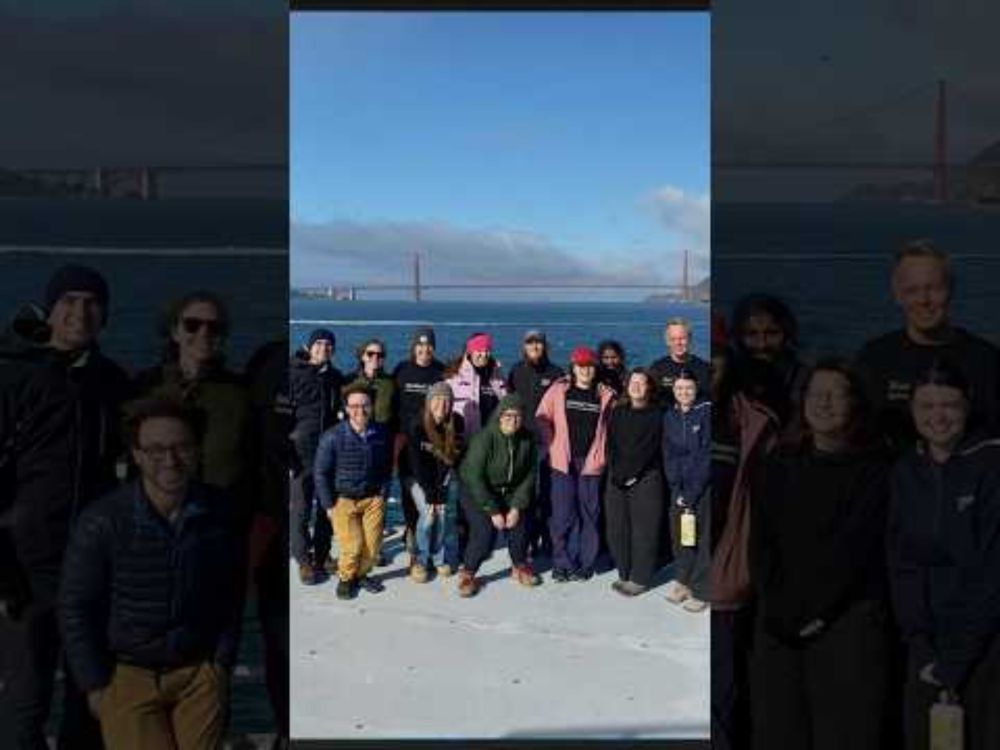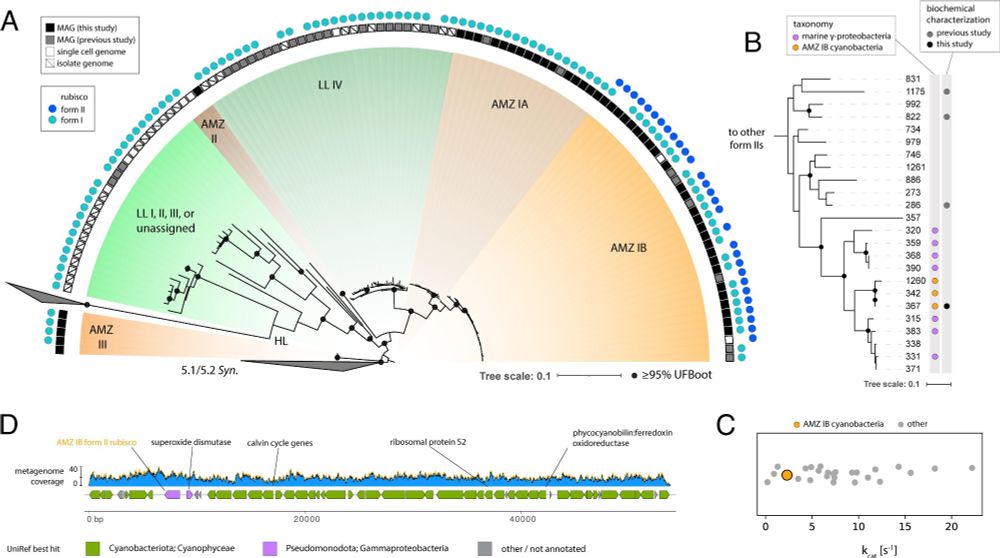Microbial N2O reduction in sulfidic waters: Implications for Proterozoic oceans
Throughout Earth’s history, shifts in ocean redox influenced the bioavailability of trace metals, shaping the activity of microorganisms. In Proterozoic oceans, the precipitation of copper (Cu) with sulfide was hypothesized to limit the bioavailability of Cu. This limitation may have suppressed microbial reduction of nitrous oxide (N2O), due to the Cu dependency of nitrous oxide reductase (Nos). It is thought that without this critical microbial sink, Proterozoic oceans were a significant net source of N2O. Here, we revisit this paradigm in light of recently derived ∼20-fold lower estimates for sulfide in Proterozoic seawater and an empirical evaluation of the potential for microbial N2O reduction under sulfidic conditions. Leveraging publicly available environmental metatranscriptomes, we infer active N2O reduction from the detection of nosZ transcripts in multiple marine and lacustrine systems in which sulfide and Cu concentrations are analogous to those of the Proterozoic. In controlled culture experiments, we demonstrate that the purple non-sulfur bacterium Rhodopseudomonas palustris can reduce N2O at sulfide concentrations up to 100 µM, well above levels predicted for Proterozoic oceans. Based on trace metal speciation modeling, we suggest that Cu remains bioavailable under Proterozoic-like conditions as a dissolved CuHS complex. Using phylogenetics, we infer that early N2O reducers were probably anoxygenic phototrophs and performed N2O reduction as dark metabolism. Collectively, these observations suggest microbial N2O reduction occurs under euxinic conditions, implying that Proterozoic marine N2O emissions were substantially lower than previously proposed. Our conclusions inform our understanding of the microbial ecology in sulfidic waters, the early climate, and the search for extraterrestrial life. ### Competing Interest Statement The authors have declared no competing interest. National Aeronautics and Space Administration, https://ror.org/027ka1x80, 80NSSC17K0296
New preprint on ancient oceans!
We challenge the idea of early Earth as major N2O source; reshaping views on climate & biosignatures. Led by S. Buessecker @annedekas.bsky.social lab!
➡️ Microbial N2O reduction in sulfidic waters: Implications for Proterozoic oceans
www.biorxiv.org/content/10.1...
07.07.2025 16:31 — 👍 15 🔁 7 💬 0 📌 0
YouTube video by stanforddoerr
Follow along on a research cruise studying microbes in the deep sea
Follow along with PhD student Jessica Bullington on a research cruise off the coast of San Francisco, part of an effort to study microorganisms in the deep sea led by @annedekas.bsky.social ⬇️
11.07.2025 19:58 — 👍 2 🔁 1 💬 1 📌 0
over a year later, this one out today!
link.springer.com/article/10.1...
16.06.2025 16:35 — 👍 35 🔁 15 💬 3 📌 0
Congratulations, Yunha!!! You are so awesome and MIT is so lucky to have you!
29.04.2025 20:02 — 👍 1 🔁 0 💬 0 📌 0


We’re on our way! Sailed under the Golden Gate Bridge on our first of 14 days at sea. We’re investigating GHG cycling by deep-sea microbes using ‘omics, isotopes, and imaging. #DARCMicrobes #RVSallyRide @stanforddoerr.bsky.social
09.04.2025 03:32 — 👍 5 🔁 0 💬 1 📌 0
Past, Present and Future of Life
Here and Elsewhere
PI: Betül Kaçar
Account managed by lab members.
✨
kacarlab.org
https://sustainability.stanford.edu/
Adjunct Prof @ SFSU | Research Prof @ EOS Center | Research Affiliate @ LBNL. Metagenomics | Oceanography | Plankton | Microbial Ecology | ML/AI | Big Data | Open Science. seanj.me
Professor, USC Marine and Environmental Biology, microbe hunter. he/him. Not a bot. thethrashlab.com
Asst Prof in Biology dept @ StFX, NS, Canada. Microbial ecology, oceanography, bioinformatics. I enjoy gardening, fermenting things, cooking, and spending time outdoors. Cover photo credit: P. McNichol.
Neuroimmune axis, mucosal immunology, microbial ecology and evolution, geobiology.
Anti-fascist. Apparently I live in a country where that has to be explicitly stated.
Microbiologist driven by curiosity. Poking microbes that make methane. Currently postdoc at UC Berkeley, Nayak lab (Molecular & Cell Biology) and Stolper group (Earth & Planetary Science) || Formerly at Weizmann Institute of Science
Earth scientist/mineralogist/geochemist. Studying interactions between the geosphere and the biosphere. How bacteria form rocks? Looking for traces of (old, extraterrestrial..) life in rocks. How bacteria impact the behavior of chemicals in the environment
Geobiology, geochemistry, environmental microbiology – PhD student @MIT, Bosak lab
Aqueous geochemist and mineralogist, soon-to-be-former journal editor-in-chief, director of an interdisciplinary undergraduate program on the environment, dog lover.
Graduate Student @UW |
Microbial Ecophysiology (Nitrification & Methanogenesis) |
Surf, hike, concerts, read
archaea, methane, microbial ecophysiology, single cell activity, next generation physiology / for evidence-based decision-making / I hold strong opinions / I don’t mince words / posts reflect personal views / www.environmental-microbiology.com
I live with a menagerie and with humans. I study environmental microbiology in the coastal zone and in sewage. I also have hobbies I sometimes do. Views are my own.
I’m a geomicrobiologist with a geologically short attention span. AquaticGeomicro.com
Microbial ecology, nutrient cycling, bioinformatics, statistics in aquatic ecosystems!
Water Quality Scientist, Riverkeeper
Kingston, NY
https://amoebalab.me
Building genomic intelligence @ Tatta Bio
Microbial ecologist exploring life in Earth's oceans & aquatic ecosystems from prehistoric to present-day 🔬🦠 Special focus on photosynthesis and the iron cycle ☀️⚡🪨 Young Research Fellow at JAMSTEC, Japan
Trying to put together microbes, ecology, and geochemistry as part of the world's coolest puzzle. Assistant professor in Earth and Planetary Sciences and Environmental Toxicology at UC Davis.
Dad, husband, nature lover, microbial ecologist, oceanographer, USC Professor. American Academy of Arts & Sciences, Am Acad Microbiology. Interested in how all life works together in the functioning of ocean ecosystems. Still just scratching the surface.






